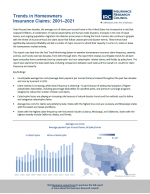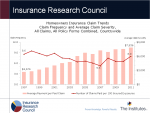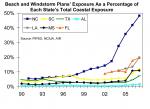Research Publications
Homeowners Insurance Affordability: Countrywide Trends and State Comparisons
This Research Brief updates homeowners insurance affordability trends through 2022 and provides countrywide projections for 2023 and 2024. State rankings for 2022 are included, along with a visual representation of key cost drivers in each state. See the IRC homepage for a FREE DOWNLOAD of this report.
Catastrophic Weather Events and Mitigation: Survey of Homeowners
This report explores public opinions and homeowners' experiences with severe weather, including analysis of U.S. regional perceptions of future risks, preparedness levels, attitudes toward mitigation strategies, post-storm solicitations by contractors and service providers, and homeowners' opinions on the roles of insurance and government in managing severe weather-related risks.
Report Summary:
Trends in Homeowners Insurance Claims: 2001–2021
This report examines homeowners insurance claim frequency, severity, and loss cost trends over two decades. The report reviews countrywide trends for all claim types and policy forms combined; then by catastrophe- and non-catastrophe- related claims; and finally, by policy form. Homeowners insurance costs vary widely by state, which is demonstrated with state-by-state comparisons and individual state profiles.
Report Summary:
Trends in Homeowners Insurance Claims, 2019 Edition
This report documents homeowners insurance claim frequency, severity, and loss cost trends from 1997 to 2018. Special emphasis is given to the role of catastrophe-related claims. Countrywide and state findings are presented.
Attorney Involvement in Homeowners Insurance Claims in Texas
This study examines a sample of closed homeowners insurance claims for property damage occurring from 2008 to 2013, exploring the distribution of the number of claims and the dollars paid across regions within the state. The rate of attorney involvement is examined, with particular focus on claims stemming from wind and hail damage. The report documents the spread of attorney involvement across counties in Texas and provides estimates for the impact of continued increases.
Trends in Homeowners Insurance Claims, 2015 Edition
This report documents homeowners insurance claim frequency, severity, and loss cost trends from 1997 to 2013. Special emphasis is given to the role of catastrophe-related claims. Countrywide and state findings are presented.
Trends in Homeowners Insurance Claims
This report documents homeowners insurance claim frequency, severity, and loss cost trends from 1997 to 2011. Countrywide and state findings are presented. Special attention is focused on the role of catastrophe-related claims. The study finds that the cost of homeowners insurance claims increased rapidly over the study period, driven primarily by a rapid increase in the severity of all claims and a slow, but steady, increase in the frequency of noncatastrophe-related claims beginning in 2006.
State Beach and Windstorm Plans, October 2010
A new study from the Insurance Research Council (IRC) describes how the role of beach and windstorm plans in some states has changed from serving as a market of last resort, to providing unintentional incentives for economic development in areas vulnerable to severe wind damage. The report explains how state-run plans interact with voluntary homeowners insurance markets and describes how each of the five state beach and windstorm plans (Alabama, Mississippi, North Carolina, South Carolina, and Texas) and two statewide plans (Louisiana and Florida) would weather a hurricane catastrophe. The study reviews each plan’s growth in insured exposure from a theoretical perspective. Individual state case studies analyze each plan's origin, operational framework, and financial structure, along with overall residual market health in each state.
Municipal Bond Holdings of Property-Casualty Insurance Companies
This IRC report describes the property-casualty insurance industry’s role as the fourth largest investor in municipal bond markets and presents findings on the types of projects funded through municipal bonds purchased by insurers.







